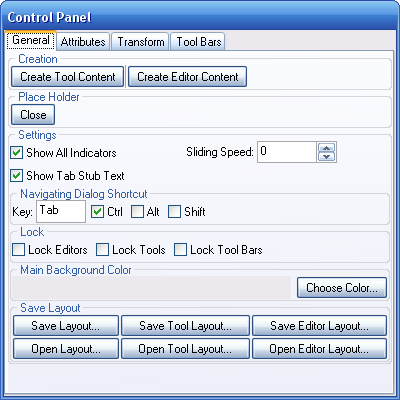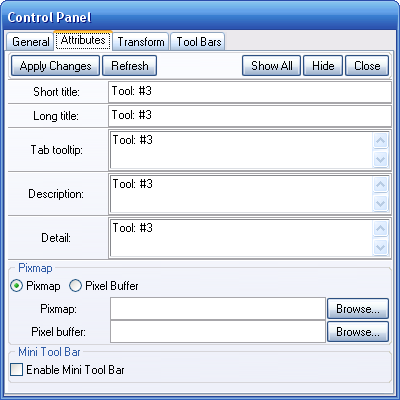Start with Smart Docking library
If this is the first time you try to play with Smart Docking library. It's recommend you to compile the examples in $EIFFEL_SRC/example/docking folder. In the folder, there are two examples:
Simple
Snapshot:
What you will found:
The basic features of Smart Docking library.
- You can try to drag the zones with name `Content 1' and `Content 2', move them around and undock them.
- See the nice dragging feedbacks.
- Try to dock `Content 1' at the sides of `Content 2', or try to tab `Content 1' with `Content 2'.
You can also play with the tool bar:
- Undock the tool bar.
- Dock the tool bar at top/bottom/left/right side of main window.
- Resize the floating tool bar to several rows.
`Ctrl + Tab' is supported, too.
Docking Control
Snapshot:
What you will found:
You can try almost all the features of Smart Docking library just by press the buttons on the control panel.
General tab's buttons and options:
- Create Tool Content: Create a zone which type is tool.
- Create Editor Content: Create a zone which type is editor.
- Place Holder close: Close the place holder zone which is the grey area in the main window.
- Show All Indicators: When dragging a zone, should Smart Docking library show all indicators same time when use transparent rectangle style feedback?
- Sliding Speed: Control the speed of auto hide tab stub sliding animation.0 means no animation.
- Show Tab Stub Text. Should auto hide tab stubs of a group always showing all the texts even some of them not active.
- Navigation Dialog Shortcut: Set the accelerator of zone navigation dialog.
- Lock Editors: Enable/Disable docking mechanism of all editor type zones.
- Lock Tools: Enable/Disable docking mechanism of all tool type zones.
- Lock Tool Bars: Enable/Disable docking mechanism of all tool bars.
- Main Background Color: Set the background color of main window when no zone docking.
- Save Layout: Save current whole docking layout to a file.
- Save Tool Layout: Save current tool type zones layout to a file.
- Save Editor Layout: Save current editor type zones layout to a file.
- Open Layout: Restore all zones docking layout from a file.
- Open Tool Layout: Open tool type zones docking layout from a file.
- Open Editor Layout: Open editor type zones docking layout from a file.
Attribute tab's buttons and options:
- Apply Changes: Set current values to target Smart Docking content.
- Refresh: If selected content's attribute changed, press this button to update the values showing in the control panel.
- Show All: Make all the contents visible.
- Hide: Hide current selected content.
- Close: Close current selected content. After close, the content is removed from Smart Docking library. It can't be visible again by pressing `Show All' button.
- Short title: The title which is shown on auto hide tab stub and notebook tab.
- Long title: The title which is shown on the top side title bar of a content.
- Tab tooltip: The tooltip text of content notebook book tab.
- Description: When show zone navigation dialog (default invoked by `Ctrl + Tab'), we use this description texts.
- Detail: When show zone navigation dialog, we use this detail texts.
- Pixmap: The icon showing on content notebook tab and auto hide tab if Gdi+ not available on Windows platform.
- Pixel Buffer: The icon showing on content notebook tab and auto hide tab if Gdi+ available on Windows platform.
- Enable Mini Tool Bar: Add/remove mini tool bar to target content. The mini tool bar is showing at the right side of content's title bar.
Transform tab's buttons and options:
- Apply Changes: Apply docking operations to target selected content.






